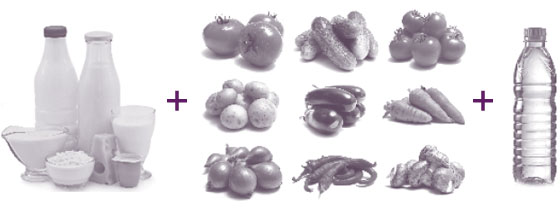Editorial: Your Health — Nonpharmacologic Management of Gout
In October 2012, the American College of Rheumatology (ACR) published a two-part guideline for the management and treatment of gout. The first ACR guideline focuses on patient education, diet, lifestyle, treatment objectives, and management of comorbidities (1). These recommendations constitute the core therapeutic measures in the management of gout. The second guideline publication addresses the clinical management of gout (2).
Gout is one of the most common rheumatic diseases of adulthood, with 8.3 million affected individuals in the U.S. alone. The incidence of gout has risen 40% from 1990 to 19993 as Americans have become older, heavier (4), and experience more comorbidities including hypertension, renal insufficiency, hypertriglyceridemia, hypercholesterolemia, diabetes, obesity, and early menopause that contribute to elevated uric acid/urate levels.
Uric acid is an end-stage by-product of purine metabolism and humans remove urate primarily by renal excretion. Gout develops when uric acid excretion cannot maintain serum urate levels below the saturation point of 6.8 mg/dL. When tissues become supersaturated, the urate salts precipitate, forming needle-like crystals that can cause inflammation and cell destruction. Gout can also be caused by overproduction of urate due to genetic anomalies, malignancies, certain hematologic disorders, chemotherapeutic agents, excessive exercise, and obesity. Gout is associated with considerable morbidity with acute episodes often causing incapacitation. Chronic tissue injury can lead to severe joint destruction and renal impairment.
Management of gout frequently requires pharmacologic intervention to relieve pain, prevent disease progression, and prevent tissue deposition of uric acid. Patient behaviors that reduce uric acid levels and prevent gout-associated comorbidities play an important role in preventing gouty flares and the associated tissue damage. The first part of the ACR guidelines focuses on these behaviors.
Foods to avoid
- Foods that have very high purine levels including hearts, sweetbreads (e.g., pancreas, thymus), liver, and kidney.
- Foods containing high-fructose corn syrup. Consumption of fructose-rich foods and beverages is associated with an increased risk of gout in both men and women. (5,6)
- Alcohol overuse (more than 2 servings/day for males and 1 serving/day for females) in patients without symptoms. All alcohol use should be avoided during gout attacks and in cases of advanced gout under poor control. Heavy drinkers are much more likely to have recurrent gout attacks, even with allopurinol therapy. (Alcohol interferes with the effectiveness of allopurinol.)
Foods to Limit
- Limit serving sizes of beef, pork, lamb and seafood with high purine content such as smelt, sardines, and shellfish.
- Limit servings of naturally sweet fruit juices, table sugar, sweetened beverages, and desserts.
- Limit table salt including salt in sauces and gravies.
- Limit Alcohol intake (particularly beer, but also wine and spirits) in all gout patients. These beverages can elevate uric acid levels and precipitate attacks of gout.
Foods that are encouraged
- Low-fat or non-fat dairy products. Dairy products are relatively low in dietary purines. Milk also contains uricosuric factors, such as orotic acid, which may promote renal uric acid excretion.
- Vegetables
- Maintaining a high level of hydration with water is helpful in avoiding gouty flares and the formation of kidney stones.

Behavior Modification Recommendations
- Weight loss in those who are overweight can lower uric acid levels.
- Smoking cessation
- Moderate exercise can reduce uric acid levels and associated comorbidities.
- Because of the association of gout with atherosclerosis, the diagnosis of gout may be a good time to start a lowcholesterol, low-fat diet. This type of diet can reduce uric acid levels and lower the risk of atherosclerosis.
Patient lifestyle choices have an important role in preventing gouty flares and the comorbidities associated with gouty attacks. Choose wisely.
Literature Cited
- Khanna D, Fitzgerald JD, Khanna PP, et al. 2012 American College of Rheumatology guidelines for management of gout. Part 1: systematic nonpharmacologic and pharmacologic therapeutic approaches to hyperuricemia. Arthritis Care Res (Hoboken). 2012;64:1431-1446.
- Khanna D, Khanna PP, Fitzgerald JD, et al. 2012 American College of Rheumatology guidelines for management of gout. Part 2: therapy and antiinflammatory prophylaxis of acute gouty arthritis. Arthritis Care Res (Hoboken). 2012;64:1447-1461.
- Terkeltaub RA. Gout: Recent advances and emerging therapies. Rheumatic Disease Clinics Update. 2008;3(1):1-9.
- Kim KY, Ralph Schumacher H, Hunsche E, Wertheimer AI, Kong SX. A literature review of the epidemiology and treatment of acute gout. Clin Ther. Jun 2003;25(6):1593-617.
- Choi HK, Willett W, Curhan G. Fructose-rich beverages and risk of gout in women. JAMA. Nov 24 2010;304(20):2270-8.
- Choi HK, Curhan G. Soft drinks, fructose consumption, and the risk of gout in men: prospective cohort study. BMJ. Feb 9 2008;336(7639):309-12.

